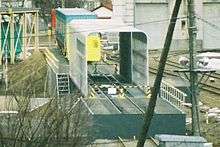Train on Train
"Train on Train" (トレイン・オン・トレイン, Torein on Torein) is a concept being developed by Hokkaido Railway Company (JR Hokkaido) in Japan as a means of transporting freight in a manner allowing higher speeds through the undersea Seikan Tunnel for both high-speed passenger services and freight services, as the Hokkaido Shinkansen started using the tunnel in 2016.[1]
Overview
Since the Hokkaido Shinkansen opened between Shin-Aomori and Shin-Hakodate in 2016, high-speed Shinkansen trains have had to share the dual gauge tracks through the 53.85 km (33.46 mi) long Seikan Tunnel linking the main island of Honshu and Hokkaido with freight trains currently limited to 110 km/h (70 mph) on narrow-gauge 1,067 mm (3 ft 6 in) tracks. Shinkansen trains were initially limited to 140 km/h (85 mph) through the tunnel due to the risk of freight containers being dislodged by the shockwave of air that builds up ahead of Shinkansen trains traveling through tunnels at higher speeds. The "Train on Train" concept involves loading narrow-gauge KoKi 100 container wagons onto specially built standard-gauge wagons, allowing freight trains to be operated through the tunnel at speeds of up to 200 km/h (120 mph).[1] Although the plan has yet to be implemented, speeds have already been increased to 160 km/h (99 mph) after extensive testing.
Development

The "Train on Train" concept was revealed by JR Hokkaido Chairman Shinichi Sakamoto in April 2006.[2] A full-size mockup vehicle was built and demonstrated at Naebo Works in spring 2007, and the next phase of the project is to build a prototype train for actual operation.[1] JR Freight is developing new Class EH800 20/25 kV AC electric locomotives to haul these and other trains through the tunnel.[3]
Addressing local business leaders at a "Forum 2050" meeting in Hokkaido on 1 February 2010, JR Hokkaido vice-president Hirohiko Kakinuma stated that using a "double traverser" arrangement would allow trains to be transferred to and from the Train on Train wagons in approximately 10 minutes.[4]
See also
- Transporter wagon, railway wagons used to carry rail vehicles of different gauge
- Gauge Change Train, an experimental Japanese train designed to operate on both narrow-gauge and standard-gauge routes
- Rollbock
- Variable gauge
- Modalohr
References
- 独自の研究開発 人と物流 高速化に活路 [Own R&D leading to increased speed]. Hokkaido Shimbun (in Japanese). Japan: The Hokkaido Shimbun Press. 20 December 2008. Retrieved 30 September 2009.
- JR北海道坂本会長 在来線使い、札幌経由で [JR Hokkaido chairman Sakamoto: Using conventional lines via Sapporo]. Tokachi Mainichi Newspaper (in Japanese). Japan. 26 April 2006. Archived from the original on 5 July 2009. Retrieved 30 September 2009.
- "JR貨物 新幹線との供用走行専用の新型機関車を導入" [JR Freight to introduce new locomotives for inter-running with shinkansen]. Tetsudō Daiya Jōhō Magazine. Vol. 41 no. 337. Japan: Kōtsū Shimbun. May 2012. p. 70.
- 在来線貨車を10分で新幹線に積み替え可能 [Narrow-gauge wagons to be transferred to shinkansen in 10 minutes]. Hokkaido Shimbun (in Japanese). Japan: The Hokkaido Shimbun Press. 1 February 2010. Archived from the original on 4 February 2010. Retrieved 2 February 2010.
External links
| Wikimedia Commons has media related to Train on Train. |
- Animated video showing operation (in Japanese)